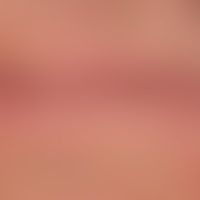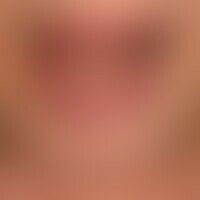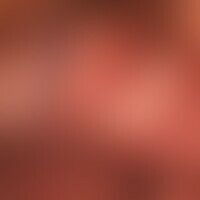Image diagnoses for "Plaque (raised surface > 1cm)", "white"
74 results with 270 images
Results forPlaque (raised surface > 1cm)white
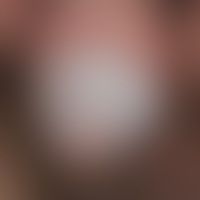
Lichen sclerosus of the penis N48.0
Lichen sclerosus of the penis: lichen sclerosus persisting for years with verrucous transformation of the surface epithelium (DD. verrucous mucosal carcinoma)

Leprosy tuberculoides A30.10
Leprosy tuberculoides (-TT-). marginal, somewhat hypopigmented and hypaesthetic plaques in the face of a small boy.

Circumscribed scleroderma L94.0
Circumscribed scleroderma (plaque-type): Extensive whitish plaques in the area of the back in young patients, continuously progressive for 10 years.

Lichen sclerosus of the penis N48.0
Lichen sclerosus of the penis: several discrete, veil-like, little sharply defined, whitish spots and plaques; dysesthetic discomfort during sexual intercourse.
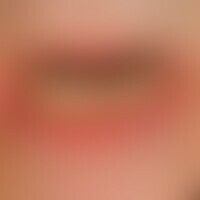
Oral Lichen planus L43.8
Lichen planus mucosae: discrete infestation of the lower lip, no subjective symptoms.

Dermatitis contact allergic L23.0
Dermatitis contact allergic: chronic contact allergic eczema caused by wearing chromate-hlated leather shoes.

Lichen planus classic type L43.-
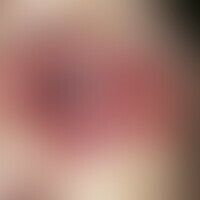
Psoriasis vulgaris L40.00
psoriasis vulgaris. localized psoriasis. no further foci! chronic dynamic, red, rough plaque covering the entire left orbital region. in addition, in the 60-year-old woman, discrete, red, slightly scaly plaques have existed for several years on the elbows, knees, sacral region, rima ani, scalp and ears (retroauricular accentuation).
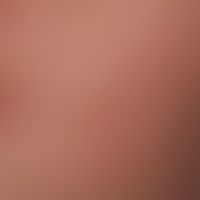
Basal cell carcinoma sclerodermiformes C44.L
Basal cell carcinoma sclerodermiformes: approx. 1.5 cm in diameter irritation-free, whitish plaque with conspicuous vessels running from the edge to the centre.

Crusted Scabies B86.x1
Scabies norvegica: excessive infestation with dirty-brown, keratotic changes in the area of the face.

Leprosy (overview) A30.9
Leprosy (overview): Borderlinelepromatous leprosy (BB), plaques and dome-shaped punch-out lesions.

Tinea corporis B35.4
Tinea corporis. multiple, chronically active, grouped, 0.5-10.0 cm large (or larger), isolated and confluent, moderately to distinctly itchy, slightly rimmed, rough, scaly bright spots (and plaques). slow growth of single florets.

Ringworm B35.2
For a long time now, this large, "well-cared for", low-consistency, borderline, sometimes itchy plaque (interval-like local treatment with corticosteroids) has existed in the 42-year-old patient.
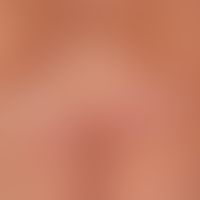
Lichen sclerosus (overview) L90.4
Lichen sclerosus et atrophicus. extensive extragenital 'infestation with typical "leathery" changes of the skin surface due to a distinct orthohyperkeratosis in the fallen areas. the areas are brightly discolored due to orhtohyperkeratosis and the underlying "edema zone". thus the natural color of the area is lost.
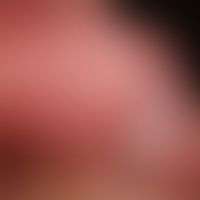
Acuminate condyloma A63.0
Condylomata acuminata, extensive macerated papules and plaques with a verrucous surface.

Ringworm B35.2
Tinea manuum: For several months now, the 40-year-old patient has had this little scaly, clearly hyperkeratotic and consistently increased plaque.
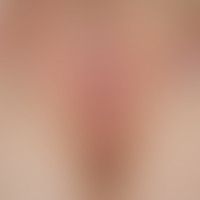
Vulvar lichen sclerosus N90.4
Lichen sclerosus of the vulva: extensive whitish sclerosing of the large labia; so far no significant symptoms except for slight itching.

Tinea capitis (overview) B35.0
Tinea capitis (microspores): diffuse infestation of the entire capillitium. only moderate itching. detection of Microspoum canis.

Lichen sclerosus (overview) L90.4
Lichen sclerosus et atrophicus generalized. large-area infestation with parchment-like skin alteration. red wheals in places, indicating that the process is "still active".
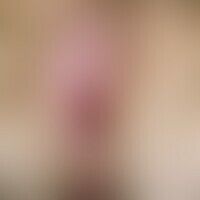
Lichen sclerosus (overview) L90.4
Lichen sclerosus et atrophicus. pinhead-sized, in places confluent, whitish shining papules. complete atrophy of the labia minora. associations with autoimmune diseases like vitiligo, alopecia areata or thyroid diseases are possible.
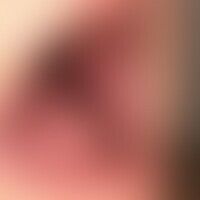
Oral Lichen planus L43.8
Lichen planus mucosae: less symptomatic white plaques on the mucous membrane of the tongue; known exanthematic Lichen planus.

Circumscribed scleroderma L94.0
Scleroderma circumscripts (plaque type). chronic, sharply defined, clearly indurated, whitish atrophic, smooth plaques with surrounding blue-violet to lilac resterythema (lilac ring). the individual plaques expand centrifugally increasingly and fade centrally. subjectively, there is only a slight feeling of tension.
